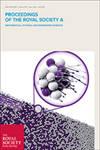A Theory of Electrons and Protons
IF 2.9
3区 综合性期刊
Q1 MULTIDISCIPLINARY SCIENCES
Proceedings of the Royal Society A: Mathematical, Physical and Engineering Sciences
Pub Date : 1900-01-01
DOI:10.1098/RSPA.1930.0013
引用次数: 559
Abstract
The relativity quantum theory of an electron moving in a given electromagnetic field, although successful in predicting the spin properties of the electron, yet involves one serious difficulty which shows that some fundamental alteration is necessary before we can regard it as an accurate description of nature. This difficulty is connected with the fact that the wave equation, which is of the form [W/ c + e / c A + ρ1 (σ, p + e / c A) + ρ3 mc ] Ψ = 0, (1) has, in addition to the wanted solutions for which the kinetic energy of the electron is positive, an equal number of unwanted solutions with negative kinetic energy for the electron, which appear to have no physical meaning. Thus if we take the case of a steady electromagnetic field, equation (1) will admit of periodic solutions of the form Ψ = u e - i E t / h , (2) where u is independent of t , representing stationary states, E being the total energy of the state, including the relativity term mc 2. There will then exist solutions (2) with negative values for E as well as those with positive values ; in fact, if we take a matrix representation of the operators ρ1σ1, ρ1σ2, ρ1σ3, ρ3 with the matrix elements all real, then the conjugate complex of any solution of (1) will be a solution of the wave equation obtained from (1) by reversal of the sign of the potentials A, and either the original wave function or its conjugate complex must refer to a negative E.电子和质子的理论
电子在给定的电磁场中运动的相对论量子理论,虽然成功地预测了电子的自旋特性,但它涉及一个严重的困难,这表明在我们认为它是对自然的准确描述之前,必须进行一些基本的改变。这一困难与以下事实有关:波动方程的形式为[W/ c + e / c A + ρ1 (σ, p + e / c A) + ρ3 mc] Ψ = 0,(1)除了电子动能为正的所需解外,还有相等数量的电子动能为负的不需要解,这些解似乎没有物理意义。因此,如果我们以稳定电磁场为例,方程(1)将允许周期解的形式为Ψ = u e - ie t / h,(2)其中u与t无关,代表稳态,e是状态的总能量,包括相对论项mc 2。则存在E为负值的解(2)和为正值的解(2);实际上,如果我们取算子ρ1σ1, ρ1σ2, ρ1σ3, ρ3的矩阵表示,且矩阵元素均为实数,则(1)的任意解的共轭复形将是由(1)通过势a的符号反转得到的波动方程的解,并且原始波函数或其共轭复形必须指向负E。
本文章由计算机程序翻译,如有差异,请以英文原文为准。
求助全文
约1分钟内获得全文
求助全文
来源期刊
CiteScore
6.40
自引率
5.70%
发文量
227
审稿时长
3.0 months
期刊介绍:
Proceedings A has an illustrious history of publishing pioneering and influential research articles across the entire range of the physical and mathematical sciences. These have included Maxwell"s electromagnetic theory, the Braggs" first account of X-ray crystallography, Dirac"s relativistic theory of the electron, and Watson and Crick"s detailed description of the structure of DNA.

 求助内容:
求助内容: 应助结果提醒方式:
应助结果提醒方式:


